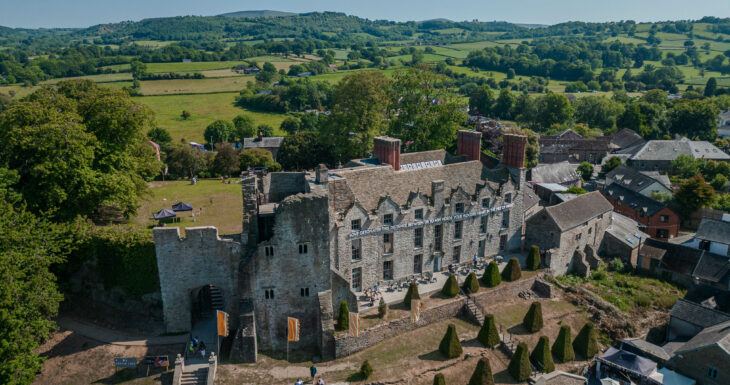Hay Castle
A beacon of art, culture, history, and food at the heart of the Town of Books.
Hay Castle, Oxford Road, Hay-on-Wye, HR3 5DG

The original Hay Castle was commissioned in the late 12th Century to control the border between England and Wales. The remains of the castle include an exceptionally well-preserved defensive keep thought to have been constructed under the supervision of the de Braose, a wealthy and powerful baronial family – Matilda de Braose, an impressive a Medieval giantess, and, her husband, William, who was renowned for murdering his enemies at a ‘peace-making’ Christmas lunch. Local legend has Matilda built Hay Castle overnight!
This part of Wales, then known as the Welsh Marches, was a strategic buffer zone between Norman occupied England and the princedoms of Wales. Norman Lords were eager to gain land in Wales and so the expansive borderlands were characterized by battles, fortifications, and defence. From the top of our tower, you can even spot a half dozen frontier castles if you know where to look!
At the base of the tower, you can also see archaeology in action – a newly revealed 12th-century arched gateway. In 2017, archaeologists unearthed a stone trebuchet ball, which was probably fired at Hay Castle in the 13th Century.
The beautiful ancient timber gates – the oldest of their kind in the UK and the ‘Gateway to Wales’ – are embedded with lead shrapnel and the imprints of musket balls, reminding us of Hay’s fractious past at the historic frontier.
Relative peace in the Welsh borders after the Act of Union, and the removal of the Marches in the 16th Century, meant that the site was transformed into a more domestic setting. A beautiful Stuart mansion was built alongside the Medieval keep – analysis of timbers dates this mansion to around 1640. Its majestic Dutch gables and stunning brick chimneys characterise the distinctive skyline of Hay.
Hay Castle (the keep and the manor) was for a long time the home of the Lords of Hay and, in the 19th Century, Joseph Bailey took up residence as Lord Glanusk. He decided to make his own alterations to the site and added a carriage drive and the coach house that you see today.
In 1845, Bailey’s cousin William Latham Bevan came with his family to live at Hay Castle as he was the vicar of Hay and there was no vicarage at the time. The Bevan family were friends of Francis Kilvert, who wrote in his diary in the 1870s about his visits and enjoying tea with them on the lawns.
After the Bevans moved out, the Dowager Lady Glanusk returned. A Country Life article from 1914 shows the renovations made to make the place more suitable for her. One of her servants, Bramwell Bradley, a young boy at the time, wrote a fascinating memoir of his time working at Hay Castle which gives us rare and precious insight into life within the castle walls.
In the 1960s, Hay Castle was purchased by the bookselling entrepreneur, Richard Booth, whose vision and charisma transformed Hay into the world’s first Book Town. Sensing an opportunity to diversify Hay’s rural economy, he purchased books in bulk from the United States, shipped them over to Hay Castle, and flooded the town with books.
In 1977, Richard Booth declared Hay to be an Independent Kingdom, with himself as its King. His quirky sense of humour saw him also declare his horse Goldie prime minister, and a new Hay Sausage created. He was extremely good at publicity and these stories made the national press.
At the end of 1977, disaster struck the castle as a fire broke out, destroying many of the original features. By the start of the new millennium, Hay Castle was very much under threat, and in desperate need of conservation.
King Richard put the property up for sale in 2011, and the charity Hay Castle Trust was formed to preserve Hay Castle and open it as a public building for the people of Hay and visitors to enjoy. Hay Castle finally opened to the public on May 26th 2022 on the first day of the annual Hay Festival.
While the Medieval Tower has been conserved to allow visitors to explore the heritage of Hay and the Welsh borderlands, the adjacent Stuart mansion has been transformed into a dynamic arts centre staging a year-round programme of cultural events on a scale not currently seen in the Welsh borderlands.
Hay Castle’s facilities include an Art Gallery, Learning Space, and Archive Room (as well as a café and shop. of course!).
